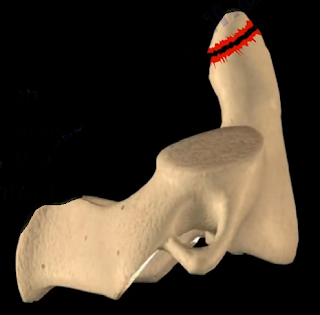Odontoid Fractures
There are three types of odontoid fractures.
Type I
fractures are a stable avulsion fracture of the alar ligament near the tip of
the odontoid. A soft collar can be used to treat Type I fractures. Be aware of
significant ligamentous injuries. Type II fractures are at the base of the
odontoid process. Type II are the most common and are troublesome. The nonunion
rate is about 20-80% due to interruption of the blood supply. The risk factors
of nonunion include if the patient is over the age of 60 years old, if the
patient has more than 6mm of displacement, smoking and diabetes, and you are
unable to achieve reduction. In posterior displacement, extension injury (rare
type) the anterior displacement is more common (flexion injury). Delay in
treatment also increases the rate of nonunion. For treatment of young patients
with no nonunion risks use a halo. The patient is younger than 60 years. The
fracture is minimally displaced. Initial dens displacement is less than 6 mm,
and the reduction is within one week of the injury. Healing will occur in the
majority of cases. If the patient has a nonunion risk, or when reduction of the fracture cannot be achieved or maintained, then we need to think about surgery and the fracture pattern. When the fracture pattern allows, you can put an anterior screw into the odontoid (to preserve the motion of C1/C2). Odontoid screw is used in younger patients instead of fusion to avoid loss of 50% of the neck rotation). Do not use the anterior screw fixation in patients with osteoporosis, in older patients, or in patients with a short neck. Another scenario is, if the patient has nonunion risks but the fracture pattern does not allow you to place an anterior odontoid screw, then you are going to fuse C1 to C2 (this will lose 50% of neck rotation). In general, C1/C2 fusion is used in cases of nonunion or it is used in cases of displaced fracture in the older patient and it can also be used if there is a failure of treatment with a halo. C1/C2 fusion can also be used if the fracture is comminuted and unstable. Posterior C1/C2 fusion can be done with different screw or wire constructs. A vascular watershed area exists between the apex of the odontoid, which is supplied by branches of the internal carotid artery and the base of the odontoid, which is supplied by branches of the vertebral artery. Type II fracture of the odontoid may get nonunion due to cortical bone and poor blood supply.
Type III fractures extend through the body of C2. This area is rich in blood supply and the fracture heals in the majority of cases. Treatment for Type III odontoid fractures includes external cervical orthosis (especially in the elderly patient) and a halo (if the fracture is displaced) (do not use in elderly patients). Odontoid fractures in the elderly can occur due to a simple fall and usually the diagnosis is missed. It is associated with increased complications and mortality. Do not use a halo in elderly patients. Use an external cervical orthosis of some sort. Fibrous union might be adequate if the fracture is not badly displaced, otherwise you will do fusion of C1/C2. For example, an 80 year old patient with osteoporosis, who is a smoker and has a displaced odontoid fracture that cannot be reduced, then this fracture will lead to nonunion and more complications. You need to do posterior C1/C2 arthrodesis. In general, if the elderly patient with an odontoid fracture is not a good surgical candidate, then you will give the patient a cervical orthosis. You can do the C1/C2 fusion by using transarticular screws, which you are not going to do if you have an aberrant vertebral artery. Another technique can be done for the fusion where fusion between C1/C2 is done with the screw placed into the C1 lateral mass and the C2 pedicle, plus a bone graft. There is increased survival for the elderly patient that undergoes surgery for Type II odontoid fracture. This may be a selection bias, because they have healthier patients who are physiologically active and young who are fit for surgery. The synchondrosis between the odontoid and the C2 body fuses by the age of 6 years.
Odontoid fracture in young children usually occurs by the age of 4 years. Physicians may confuse the synchondrosis with a fracture. The treatment of odontoid fracture in children is done with a Minerva brace or halo vest, if the fracture is displaced. You will use more pins and less torque. Finger tighten the pins. The Os Odontoideum looks like a fracture. It is oval shaped, it has sclerotic edges, and Os is smaller than the normal dens. The Os Odontoideum is a congenital process. The mechanism that causes the Os Odontoideum is unknown, but it is probably developmental or it can result from an old trauma.



